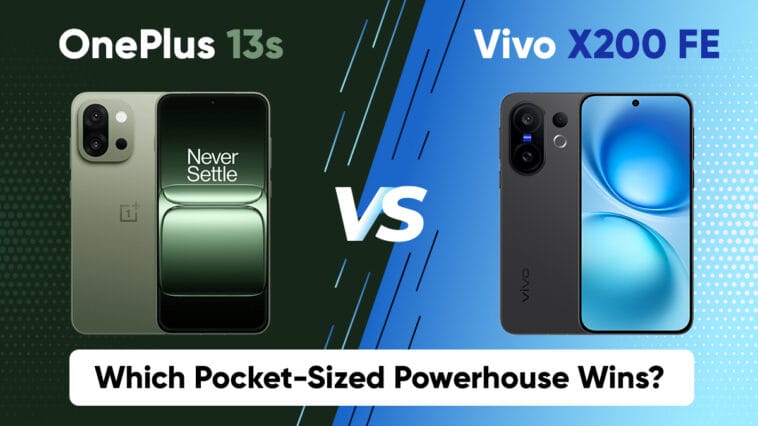In a world where huge phones are the norm, two pocket-sized powerhouses have appeared to challenge the status quo. We’ve got the OnePlus 13s and the Vivo X200 FE, both powerful devices with high-refresh-rate AMOLED displays, as well as serious camera chops and blazing-fast charging. They’re excellent choices if you’re looking for a smaller device. But which one really earns a spot in your pocket—and your daily life? Whether you’re after raw performance, killer battery life, or just the best all-around value under ₹55K, we’ve got you covered with this in-depth comparison – OnePlus 13s vs Vivo X200 FE!
OnePlus 13s vs Vivo X200 FE: Specs Comparison
FEATURES | OnePlus 13s | Vivo X200 FE |
Display | 6.32″ LTPO AMOLED, 120 Hz, ~1,600 nits peak | 6.31″ LTPO AMOLED, 120 Hz, ~5,000 nits peak |
Dimensions | 150.8 × 71.7 × 8.2 mm, ~185 g | 150.8 x 71.8 x 8 mm, ~186g |
Chipset | Snapdragon 8 Elite | MediaTek Dimensity 9300+ |
RAM & Storage | 12 GB RAM, 256/512 GB UFS 4.0 | 12/16 GB RAM, 256/512 GB UFS 3.1 storage |
Rear Camera | Dual 50 MP: Wide (f/1.8, 1/1.56″, OIS) + Telephoto (f/2.0, 2× optical zoom) | 50 MP (f/1.9, 23mm (wide), 1/1.56″, 1.0µm, PDAF ) main + 8 MP ultrawide + 50 MP periscope telephoto |
Front Camera | 32 MP, f/2.0, 21 mm wide lens, AF | 50 MP autofocus selfie camera |
Battery & Charging | 5,850 mAh typical (5,700 mAh rated), 80 W SUPERVOOC fast charge | 6,500 mAh typical (6,340 mAh rated), 90 W FlashCharge |
OS | OxygenOS 15 (Android 15) | Funtouch OS 15 (Android 15) |
Build & Resistance | Compact, durable design, IP65 dust tight and water resistant | IP68/IP69-rated durability, aerospace-grade metal frame |
OnePlus 13s vs Vivo X200 FE: Design and Build Quality
Both the OnePlus 13s and Vivo X200 FE make a strong statement when it comes to compact design, but their approaches to materials and durability differ in interesting ways.
OnePlus 13s

The OnePlus 13s boasts a sleek 150.8 × 71.7 × 8.2 mm body that weighs around 185g, giving it a satisfyingly dense, premium feel in the hand. Its industrial look is accentuated by a smooth, curved rear panel and a polished finish that keeps fingerprints in check.
The OnePlus 13s is also IP65 water and dust resistant, meaning it’s mostly safe from accidental splashes or a rainy-day scroll session. The 6.32″ LTPO AMOLED display dominates the front with subtly curved edges, contributing to its ultra-modern aesthetic.
Vivo X200 FE

Meanwhile, the Vivo X200 FE brings an equally premium edge but with a bolder and more outdoorsy spirit. Vivo leans into ultra-compact design language with a lightweight chassis that remains easy to grip. It’s built with aerospace-grade metal for the frame and is officially certified with IP68 and IP69 ratings.
The flat 6.31″ LTPO AMOLED display, with minimal bezels and a center punch-hole camera, gives it a clean and minimal front aesthetic. The front of the glass display features Schott Xensation Core protection, which features a Mohs hardness level of 5 and should keep your screen safe from scratches.
OnePlus 13s vs Vivo X200 FE: Performance
If you’re the kind of user who needs your phone to handle everything from casual scrolling to competitive gaming, both the OnePlus 13s and Vivo X200 FE are absolute beasts.
OnePlus 13s
At the heart of the OnePlus 13s is the Snapdragon 8 Elite Edition, a customized version of Qualcomm’s powerhouse mobile platform. Built on the 3nm TSMC process, this chip has been optimized specifically for OnePlus devices, delivering more stable thermal performance and longer sustained speeds under heavy loads.
In day-to-day usage, it’s fast, snappy, and responsive. Multitasking is smooth, app launches are instant, and there’s barely a hiccup even when editing videos or running multiple demanding apps. It pairs with 12GB of LPDDR5X RAM and 256GB/512GB of UFS 4.0 storage, ensuring lightning-fast read/write speeds—perfect for high-performance gaming or content creation.
Synthetic Benchmark | Score |
GeekBench 6 (Single-core) | 3005 |
GeekBench 6 (Multi-core) | 9051 |
Antutu 10 | 2497190 |
3DMark | 6423 |
GPU-wise, it runs the Adreno 830, which handles intensive titles like Genshin Impact and PUBG: Mobile at max settings without dropping frames. On top of that, OnePlus has integrated a new cooling system that helps prevent throttling during long sessions.
Vivo X200 FE
Over on Vivo’s side, the X200 FE is powered by the MediaTek Dimensity 9300+, built on a 4nm process. This chipset features an all-big-core architecture (no efficiency cores here), designed to push serious power at every level—especially in gaming and multitasking.
When it comes to graphics, the Immortalis-G720 MC12 GPU in the X200 FE performs impressively. Combined with up to 16GB of LPDDR5X RAM and UFS 3.1 storage, and you have a pretty good set of specs to run all your apps and games smoothly.
Synthetic Benchmark | Score |
GeekBench 6 (Single-core) | 1920 |
GeekBench 6 (Multi-core) | 6505 |
Antutu 10 | 1804002 |
3DMark | 4620 |
In raw benchmarks, the Snapdragon 8 Elite routinely outperforms the Dimensity 9300+ chipset by a small margin. If you’re not a number fiend however, you’ll find that the X200 FE performs just as well as its Snapdragon counterpart in IRL usage.
OnePlus 13s vs Vivo X200 FE: Camera and Video
It’s no longer enough for a smartphone camera to just “take good pictures”—users now expect versatility, cinematic quality, and low-light wizardry. Vivo and OnePlus have both featured excellent cameras, so let’s see how they match-up in this comparison.
OnePlus 13s
The OnePlus 13s keeps things tight and focused with a dual 50 MP rear camera setup, which has become a point of contention. The main sensor is a 50 MP, f/1.8, 24 mm wide camera featuring multi-directional PDAF and OIS, using a 1/1.56″ sensor size and 1.0µm pixels. It captures clean, dynamic shots with strong contrast most of the time, but can also create images that are surprisingly flat looking.
Backing it up is another 50 MP telephoto lens, f/2.0, with 2x optical zoom and PDAF, using a 1/2.75″ sensor and 0.64µm pixels. The level of detail here is softened a little compared to the main camera, and the zoom effect is good. The macro performance however is disappointing, and it’s very unfortunate to have no ultra-wide camera.
On the front, the OnePlus 13s features a 32 MP selfie camera, f/2.0, with a 21 mm wide lens, making it ideal for group selfies and vlog-style shooting. Selfies are natural looking, but look way too soft.
Video performance is excellent on the OnePlus 13s, with excellent amounts of detail, natural colour grading and visibly punch HDR effects. While the rear camera offers both 60fps video recording and HDR, the front does neither, which is a shame.
Vivo X200 FE
Vivo is playing in the big leagues with its Zeiss-partnered triple-camera setup. At the core is a 50 MP main sensor with OIS, which delivers exceptional clarity and low-light performance. While the sensor here is technically a slightly weaker version of the flagship X200’s, images are consistently fantastic and in-line with some of the best on the market.
There’s also a 50 MP periscope telephoto lens with 3x optical zoom, though Vivo has swapped the typical periscope for an M-style prism that doesn’t focus and closer than 55cm. It’s not the best, but it’s an acceptable compromise, and the performance is still great with good dynamic range, colours and sharpness.
We also have an 8 MP ultrawide lens, unlike the OnePlus 13s, though it’s not particularly impressive. Sharpness is lacking, and there’s no autofocus, almost invalidating its advantage. Up front, the 50 MP autofocus selfie camera puts many others to shame. Outside of slightly muted colours, it shoots fantastic selfies compared to the competition in its price range.
Finally, when it comes to video, the X200 FE can record 4K at 60FPS with all of its cameras. The main camera is the only with ‘Ultra stabilization’, though even then we find it lags behind the OnePlus 13s a little. There’s a bit too much post-processing happening with video on the X200 FE, and while footage is clear, the electronic stabilization can often look too artificial.
OnePlus 13s vs Vivo X200 FE: Battery Life and Charging
For compact phones, we’re happy to see that the OnePlus 13s and Vivo X200 FE both manage to cram in impressive battery setups. Let’s break things down further in the comparison.
OnePlus 13s
The OnePlus 13s brings serious endurance to the compact segment with a 5,850 mAh typical battery (around 5,700 mAh rated), based on official specs and lab data. Built with a dual-cell design, it spreads charging heat evenly allowing for sustained performance under heavy use.
Charging is handled by 80 W SUPERVOOC fast charging, enabling a near-full charge in around 35 minutes. While it lacks wireless charging support, it does offer a 5 W reverse wired charging feature, great for topping up accessories like earbuds in a pinch.
We’re also big fans of the bypass charging feature, available as a gaming feature on the OnePlus 13s. It allows the phone to bypass the battery when you charge and game at the same time. This effectively allows your device to stay cool while you play.
Vivo X200 FE
The Vivo X200 FE demands attention for its endurance chops, packing an impressive 6,500 mAh typical capacity (with a 6,340 mAh rated capacity). At this size, the Vivo X200 FE is naturally an endurance monster, and can easily handle over a day of on-screen usage without a sweat.
Add to that 90 W FlashCharge, and you get ultra-fast wired charging—without compromising on runtime. Granted, it still takes about an hour to fully charge the device thanks to the larger cell. If wireless convenience is on your checklist, we unfortunately have to inform you that the X200 FE has no wireless charging.
OnePlus 13s vs Vivo X200 FE: Connectivity
Both the OnePlus 13s and Vivo X200 FE are loaded with the latest wireless and wired features to keep you connected, whether you’re gaming online, streaming 4K content, or transferring files at high speeds.
OnePlus 13s
The OnePlus 13s is armed with Wi-Fi 7 support, giving it access to ultra-fast data rates and better multi-device stability—perfect for crowded networks and high-demand streaming. If you’re running a mesh Wi-Fi system or a modern fiber plan, this works in tandem with it.
On the cellular side, it’s fully 5G-ready, with support for multiple SA/NSA bands, ensuring wide compatibility across Indian telecom providers like Jio, Airtel, and Vi.
It also features:
- Bluetooth 5.4: Great for energy-efficient audio and accessories.
- NFC: For fast tap-to-pay and pairing.
- Dual stereo speakers with Dolby Atmos support: Ideal for games, music, and movies.
- USB Type-C (USB 3.1): Enabling faster data transfers and video output capabilities.
And yes, an IR blaster is also onboard—useful for controlling TVs and air conditioners, a niche but beloved feature for many in the Indian market.
Vivo X200 FE
The Vivo X200 FE doesn’t lag behind either. It supports Wi-Fi 6—not quite as advanced as Wi-Fi 7, but still plenty fast and stable for 99% of users.
For mobile data, it’s equipped with 5G SA/NSA bands tuned for India and international roaming, meaning it’ll work seamlessly no matter where you are.
You’ll also get:
- Bluetooth 5.3
- NFC
- USB Type-C (USB 2.0) – slower in data transfer compared to the OnePlus 13s and no video output capabilities
- Dual stereo speakers
- And yes, an IR blaster as well
OnePlus 13s vs Vivo X200 FE: Pricing and Value
Both the OnePlus 13s and the Vivo X200 FE aim to pack flagship-level specs into compact, affordable frames. But which one actually offers better value?
OnePlus 13s
In India, the OnePlus 13s launched at ₹54,999 for the 12GB RAM + 256GB storage variant, and ₹59,999 for the 12GB RAM + 512GB storage variant. It’s a competitive price within the premium mid-range smartphone space, especially for a big name. For that price, you’re getting:
- A Snapdragon 8 “Elite” variant, which handles demanding games, multitasking, and AI tasks with ease
- Dual 50MP rear cameras with flagship-grade OIS providing better video recording
- A stunning 6.32″ LTPO AMOLED 120Hz display with super slim bezels
- 5850mAh battery, 80W SUPERVOOC fast charging, and 5W reverse wired charging
- Premium build with IP65 rating
That’s a flagship-lite setup at a price that seriously undercuts the usual ₹60K+ territory. For power users on a budget, it’s a very compelling deal.
Vivo X200 FE
The Vivo X200 FE comes in at the exact same price, ₹54,999 for the 12GB + 256GB configuration. Vivo does however offer a greater 16GB RAM + 512GB storage option at ₹59,999. For that price, you’re getting:
- The MediaTek Dimensity 9300+ chipset, a solid chipset that slightly trails behind the Snapdragon 8 Elite in raw power
- Triple-camera setup, headlined by a 50MP Sony IMX921 sensor with OIS, shoots better images but worse at video recording
- 6.31-inch AMOLED 120Hz display with flat edges and 1.5K resolution
- A massive 6,500mAh battery with 90W FlashCharge
- Clean design with a metal frame and IP68/IP69 dust and water resistance
At the same price as the OnePlus 13s, the Vivo X200 FE delivers a larger battery, bigger display, better camera performance, more RAM and several features that might tip the scale for casual users who value convenience and longevity over raw horsepower.
OnePlus 13s vs Vivo X200 FE: Conclusion
Both the OnePlus 13s and the Vivo X200 FE serve as excellent mid-range smartphones, but which one is the better purchase? As usual, the answer depends on what you personally need out of a device, as both excel in different aspects.
The OnePlus 13s comes with cleaner software, slightly more powerful hardware, superior video recording and a cooling system. Meanwhile, the Vivo X200 FE features slightly less power, but sports a better camera for photography, a bigger battery with more battery life, higher RAM options, faster charging and better water and dust resistance.
For the average person, we’d personally recommend the Vivo X200 FE. Its bigger battery, better IP rating and great camera make it a better all-around device, and the difference in performance isn’t big enough to matter in day-to-day use. If you’re a gamer or someone who shoots plenty of video, then the OnePlus 13s gets the advantage here.
OnePlus 13s vs Vivo X200 FE: FAQ
Both phones ship with Android 15 and offer solid software roadmaps. OnePlus promises 3 Android updates + 4 years of security patches, while Vivo offers 3 years of Android upgrades and regular security updates as well. That said, OnePlus tends to deliver updates a little faster in practice.
It depends on what you’re after. The OnePlus 13s handily beats the Vivo X200 FE when it comes to video recording, while the Vivo X200 FE has more options with its ultra-wide lens, and also generally takes better images in both normal and low light.
The Vivo X200 FE boasts a massive 6500mAh battery, compared to the 5850mAh cell on the OnePlus 13s. While both phones offer fast charging, Vivo edges ahead in terms of battery longevity, especially with its power-efficient tuning. However, real-world difference is modest, and both comfortably last over a day.
Also read:
All You Need To Know About Different Display Technologies
Xiaomi 15 vs Oneplus 13: Is Oneplus 13 Worth the Extra Cost?
iQOO 13 vs OnePlus 13: Is the Oneplus 13 Worth the Extra Cash?




Comments
Loading…